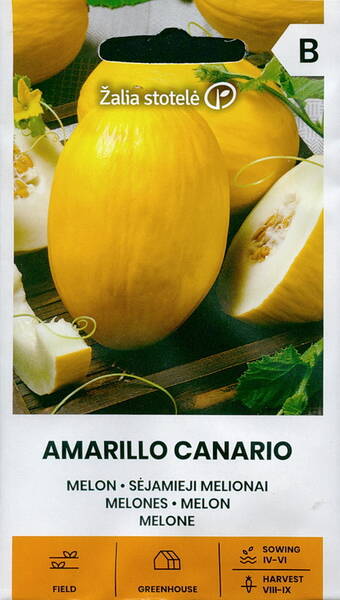A mid-early, high-yielding variety. The plant has a medium-sized vine. The fruits are oval, smooth, yellow, without a pattern or mesh, small, and individually sized, weighing 1.5-2.8 kg.
The flesh is light yellow, sweet, juicy and very aromatic.
Value of the variety : resistance to anthracnose and fusarium, excellent taste and aroma of fruits, excellent storage and transportation.
In areas with unstable agricultural practices, it is recommended to grow the plants under plastic covers, either spreading them out or in greenhouses on trellises. Stems are pinched after 5-6 leaves, leaving 3-5 fruits on the plant. Watering should be stopped 10-15 days before ripening.
It is eaten fresh, used for making candied fruits, drying and curing.
1.0 g = 25-40 seeds.
* EARLY VARIETIES ARE MORE PROFITABLE.
The wide variety of shapes and varieties available on the market makes it possible to select very early melons with a growing season of 65-75 days. In moderately warm summers, this period can be somewhat longer.
Fruits picked a little early ripen while stored, but it is still preferable to let them ripen on the plant - then the taste will be better.
Dutch, American and Japanese melon hybrids for greenhouses require a high level of agricultural technology.
Asian melons are very light-loving, requiring a lot of warmth and fertile soil. They are also susceptible to fungal infections in high-humidity conditions. Therefore, it is impossible to obtain high-quality produce in our northern latitudes: the fruit's flavor is greatly distorted—instead of a pear, vanilla, or pineapple flavor, a primitive, grassy note prevails.
Late winter varieties of Asian melons practically do not ripen, because their growing season is very extended.
HOW TO CARE FOR SEEDLINGS?
Seedlings should be sown in late April or early May, so that they are 30-35 days old when planted in their permanent location. Sow earlier, and the seedlings will overgrow and become very leggy. Planting plants as young as 25 days is also acceptable, but in this case, it is better to sow early-ripening varieties. Use 10 cm peat pots or other containers for sowing. A nutritious soil mixture is prepared from peat, humus, and garden soil with the addition of ash (0.5 cup per 5 liters of mixture). One to two days before sowing, place the seeds on a damp cloth or filter paper and keep them in a warm place at a temperature of 25 to 30 °C to germinate. Before sowing, water the soil with a strong solution of potassium permanganate. Sow one seed per pot, then water with settled water at room temperature and cover with plastic wrap. When seedlings appear, remove the film. The optimal temperature for seed germination is +25°C to +30°C; in this case, seedlings will emerge within 48 hours.
COMBINE CULTURES.
You don't have to devote your entire greenhouse to melons. You can start by growing a few plants that won't require much space or maintenance.
The best "neighbors" for melons are tomatoes or peppers, not cucumbers, even though they are related crops. Tomatoes are preferable because they are grown until they reach biological maturity, rather than being picked as greens after 2-3 days, like cucumbers.
Water as needed, allowing the soil to dry out slightly—remember that melons are heat-loving and drought-tolerant. As the seedlings grow and develop, fertilize and loosen the soil as you would any vegetable seedling (such as cucumbers). A complete fertilizer can be used. Avoid high concentrations of fertilizer to avoid damaging the delicate root system. Avoid using dry fertilizers; mineral fertilizers must be diluted in water. Good-quality melon seedlings usually have 5-6 true leaves, and the plants appear strong, healthy, and stocky.
DO NOT RUSH WITH DISEMBARKATION.
It's important to remember that melon plants require warmth, dry air, and light. The soil in the greenhouse should be fertile and loose, neutral or slightly alkaline. If the soil is acidic, chalk or ash should be added; lime should be added beforehand. Fresh manure should not be applied to melons; compost or rotted manure and mineral fertilizers should be used.
Remember that excessive doses of organic fertilizers, like mineral ones, reduce the quality of fruits, giving them a grassy taste, and also increasing the nitrate content.
The timing of seedling planting depends on the outside nighttime temperature (frost is dangerous for melon plants). The optimal time is late May to early June.
In greenhouses, seedlings are placed in beds. Holes are made in prepared soil and watered first. A pink solution of potassium permanganate can be added to reduce the risk of mold. If the seedlings were grown in peat pots, they are planted in their permanent location along with the pots.
Don't plant the plants too deeply into the soil to prevent stem rot. Avoid planting them too closely—typically, 2-3 plants are placed per square meter, or 3-4 for more compact varieties and hybrids. Water thoroughly after planting.
* Botanical information.
Melon is an annual, cross-pollinated plant with a long (up to 3.0 m) creeping stem. The leaves are rounded-angled or weakly serrated, and the tendrils are simple. The flowers are yellow and monoecious. A single plant produces 2 to 8 fruits. Their shape is quite varied - flattened, spherical, oval, and elongated. The bark is green, yellow, orange, or white, often with a pattern of stripes or spots, and may have a net. The flesh is white, yellow, cream, pale green, orange, and, rarely, pink.
To speed up the process of seed germination, improve plant health, and fruit set, it is recommended to use specially developed plant growth and development stimulants.
In Estonia, melons can be grown in a glass or plastic greenhouse, a hotbed, or even on a glassed-in balcony using seedlings. In more southern regions, a greenhouse is needed only for seedlings, and during the growing season, the plants will thrive in the open ground.












